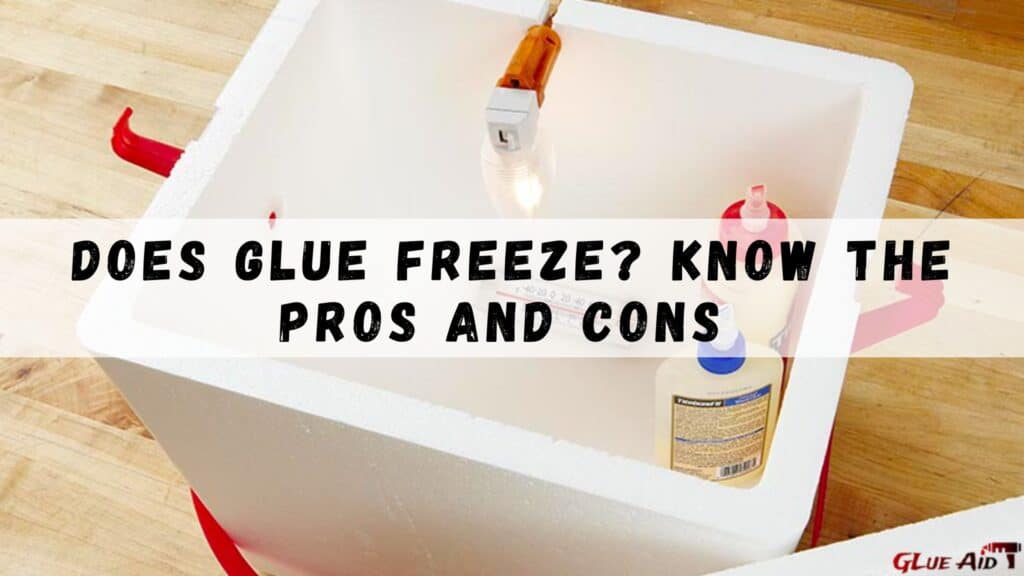Can wood glue freeze? It’s a common question that DIY enthusiasts and woodworking enthusiasts often ask. So, let’s dive into the fascinating world of wood glue and explore whether it can withstand the icy grip of freezing temperatures.
Wood glue is a handy adhesive that craftsmen and hobbyists use to bond wood pieces together. But what happens when the temperature drops? Can wood glue freeze and lose its effectiveness?
When the mercury dips below freezing, wood glue can indeed freeze. However, the crucial thing to note is that freezing doesn’t necessarily mean the end of its adhesive properties. Wood glue can often be thawed and brought back to its original state with a little effort.
So, if you’ve ever wondered about the freezing point of wood glue and its potential impact on your projects, keep reading to find out more. We’re here to break it down in a way that’s simple, informative, and fun!

The Effects of Freezing on Wood Glue
When working on woodworking projects, it’s not uncommon to encounter situations where your wood glue is exposed to low temperatures. But can wood glue freeze? In this article, we’ll explore the effects of freezing temperatures on wood glue and provide you with all the information you need to know to ensure the effectiveness of your adhesive even in chilly conditions.
Understanding Wood Glue Composition
Wood glue, commonly known as carpenter’s glue or PVA glue (polyvinyl acetate), is a popular adhesive used in woodworking projects. It is known for its strong bonding properties, making it a go-to choice for woodworkers. Wood glue is typically composed of water, a polymer called polyvinyl acetate, and other additives like various resins, solvents, and stabilizers. The glue creates a bond by drying and hardening as the water evaporates, leaving behind a strong adhesive film.
One important thing to note is that, unlike other glues, wood glue does not chemically react to cure. Instead, it relies on evaporation of water for the hardening process. This unique property makes wood glue susceptible to certain environmental conditions, including temperature. Let’s dive deeper into the effects of freezing temperatures on wood glue.
The Effects of Freezing Temperatures on Wood Glue
When wood glue is exposed to freezing temperatures, it can undergo structural changes that affect its performance and usability. Freezing causes the water component of the glue to freeze, which expands and disrupts the overall composition. As a result, the glue may develop an uneven consistency, become lumpy, or separate into different layers.
Additionally, freezing temperatures can also lead to a decrease in the shelf life of wood glue. The repeated freezing and thawing cycles can cause the glue to deteriorate and lose its bonding strength over time. It is important to note that different brands and types of wood glue may have varying degrees of resistance to freezing temperatures, so always refer to the manufacturer’s instructions for specific guidelines.
While freezing can impact the quality of wood glue, it doesn’t necessarily render it useless. In many cases, the glue can still be salvaged by allowing it to thaw and then thoroughly mixing it to restore its original consistency. However, it’s important to keep in mind that the bonding strength of the glue may be compromised, so it is advisable to test it on a scrap piece of wood before using it on your project.
Tips for Using Wood Glue in Freezing Conditions
Woodworking projects often need to be completed regardless of the weather conditions, which means that using wood glue in freezing temperatures can sometimes be unavoidable. Here are some tips to help you maximize the effectiveness of wood glue in cold weather:
1. Store Glue Properly:
Ensure that your wood glue is stored in a temperature-controlled environment. Extreme heat or cold can damage the adhesive properties of the glue. Ideally, wood glue should be stored in a dry location at temperatures between 50°F and 75°F.
2. Warm Up the Glue:
If you anticipate working in freezing temperatures, it’s a good idea to warm up the glue before using it. You can do this by placing the glue bottle in a container of warm water for a few minutes to bring it to a more workable temperature.
3. Maintain Ideal Working Conditions:
While working, try to maintain the temperature of your working area as close to room temperature as possible. Working in a heated space or using heat-generating tools can help prevent the glue from freezing before it dries.
4. Allow for Extra Drying Time:
When using wood glue in cold conditions, it may take longer for the glue to fully dry and cure. Be patient and allow extra time for the glue to set before subjecting the project to any stress or pressure.
5. Test the Glue:
If you’re unsure about the quality or effectiveness of wood glue that has been exposed to freezing temperatures, it’s always a good idea to perform a test before using it on your project. Apply a small amount of the glue to a scrap piece of wood and check the bonding strength after it has fully dried.
Can Wood Glue Freeze? The Verdict
In conclusion, wood glue can indeed freeze. Freezing temperatures can cause structural changes in wood glue, resulting in potential inconsistencies and reduced bonding strength. However, it is often possible to salvage frozen wood glue by allowing it to thaw and thoroughly remixing it. By implementing the tips mentioned above, you can ensure that your wood glue remains effective even in freezing conditions. Remember to always follow the manufacturer’s instructions and store your wood glue in optimal conditions to extend its shelf life and maintain its adhesive properties.
Key Takeaways: Can Wood Glue Freeze?
- Wood glue can freeze if exposed to extremely low temperatures.
- Freezing can affect the quality and performance of the glue.
- It is important to store wood glue in a cool and dry place to prevent freezing.
- Thawed wood glue may not regain its original properties and may result in weak bonding.
- If you suspect your wood glue has frozen, allow it to thaw and perform a test before using it for important projects.
Frequently Asked Questions
Below are some common questions about the freezing of wood glue and their answers:
1. Can wood glue freeze?
Yes, wood glue can freeze under certain conditions. Most wood glues contain water as a key ingredient, and water freezes when it reaches a temperature of 32 degrees Fahrenheit (0 degrees Celsius). Therefore, if the temperature drops below this threshold, the water in the wood glue can freeze, affecting its performance.
It’s important to note that freezing temperatures might not have an immediate impact on the glue, but it could alter its properties after thawing. If the glue has been exposed to freezing temperatures, it is advisable to check its consistency and performance before using it on important woodworking projects.
2. What happens if wood glue freezes?
When wood glue freezes, the water particles within the glue form ice crystals. These ice crystals can break the chemical bonds in the glue, affecting its strength and adhesion properties. Once thawed, the glue might become lumpy, grainy, or separated, making it difficult to work with and compromising its bonding capabilities.
If you suspect that your wood glue has frozen, it’s best to allow it to thaw at room temperature before using it. After thawing, thoroughly mix the glue to restore its original consistency. However, keep in mind that the overall quality and effectiveness of the glue may have been compromised, so it’s recommended to test small samples first before using it on important woodworking projects.
3. How can I prevent wood glue from freezing?
To prevent wood glue from freezing, it’s crucial to store it in a temperature-controlled environment. Ideally, the glue should be stored in a cool, dry place with a temperature above freezing. If you live in an area with harsh winters, consider storing the glue in a heated room or using insulated storage containers.
Additionally, avoid leaving the glue exposed to freezing temperatures for extended periods. If you’re working in a cold environment, ensure that the glue is kept warm, either by using a space heater or storing it in a heated container. Taking these precautions will help maintain the glue’s integrity and ensure its optimal performance.
4. Is it safe to use wood glue that has been frozen?
Using wood glue that has been frozen is generally not recommended. Freezing can alter the glue’s consistency and compromise its bonding strength. It’s best to thaw the glue at room temperature and thoroughly mix it to restore its original consistency before using it.
However, keep in mind that the freezing process might have permanently affected the glue, significantly reducing its effectiveness. Therefore, it’s advisable to test small samples on non-critical projects before using the thawed glue on important woodworking projects.
5. What are some signs that wood glue has been affected by freezing?
There are several signs that wood glue may have been affected by freezing. These include a lumpy or grainy texture, separated or curdled appearance, or a change in color. If you notice any of these signs after thawing the glue, it’s advisable to discard and replace it with a fresh batch.
Additionally, if the glue fails to adhere properly or doesn’t provide the expected strength, it might be an indication that freezing has compromised its bonding properties. It’s always better to err on the side of caution and use fresh glue for critical woodworking projects to ensure optimal results.

What to do when glue freezes?
Summary
Wood glue can indeed freeze, which can affect its performance and effectiveness. Freezing can cause the glue to become thick and clumpy, making it difficult to work with.
If wood glue freezes, it is important to allow it to thaw at room temperature before using it. Once thawed, the glue may not have the same adhesive strength as before freezing and may not bond as effectively. It is advisable to test the glue on a small, inconspicuous area before using it on a larger project after it has been frozen.
In order to prevent wood glue from freezing, it is best to store it in a cool, dry place above freezing temperatures. This will ensure that the glue remains in its optimal condition and can be used for various woodworking projects effectively.
